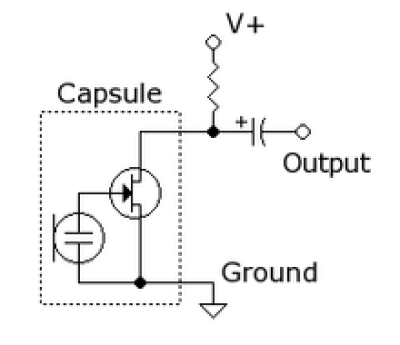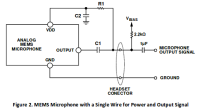son:micro
Table des matières
Faire ses propres micros
Déja la connexion d'un micophone en TRRS ( le truc des telephones/smartphone ): 

 Electret circuit The value of the resistor is usually between 2k and 10k (cap say 10uF or higher)
Electret circuit The value of the resistor is usually between 2k and 10k (cap say 10uF or higher)
- casque ouvert qui irait avec ? dans l'idée de faire un casque écoute & enregistrement
- Sennheiser PX 100-II
- Sennheiser HD 407
- Philips Fidelio X2
Connexion des électrets
autres trucs
Microphone ultrason
connexion des micro MEM
MEM Analogique
------- - |3 2|---------> | | 1 = output analog audio | | 2 et 3 et 5 et 6 = GND | 6 | 4 = VDD (1,3V a 3,6V) en général + |4 5 1|---||----> -------
1uF sur la sortie audio et si MICBIAS 2,2uF en plus BIAS/VDD
R1=499 ohm
C2=10uF C1=1,8uF Resistors R1 and RBIAS form a voltage divider with the MEMS microphone to bring the VBIAS voltage down to the upply voltage at the VDDpin. Depending on the values of VBIAS, RBIAS and the desired VDD voltage, Resistor R1 ay need to be very small, as is seen in the example below. The necessary series resistance (RBIAS + R1) can be alculated by modeling the microphone as a resistor through which a fixed current is flowing. The typical supply current of the ADMP504 when VDD = 1.8 V is 180 μA. Using Ohm’s law with 1.8 V on VDD, this microphone can be odeled as a 10 kΩ resistor. The voltage divider equation used to solve for the appropriate value for resistor R1 is:
[Microphone VDD] = [Bias voltage] × (10 kΩ/(10 kΩ + R1 + RBIAS)).
From this equation, it can be calculated that a 2.2 kΩ RBIAS resistor and a 499 Ω R1resistor divide the voltage rom the 2.2 V bias voltage to the 1.73 V microphone VDD. There is a trade-off in choosing the value of R1; a higher value results in a lower VDD, but this larger value may also be necessary to prevent C2 from being too arge, as described below.
Hydrophones
son/micro.txt · Dernière modification : 2024/02/09 17:10 de 127.0.0.1


